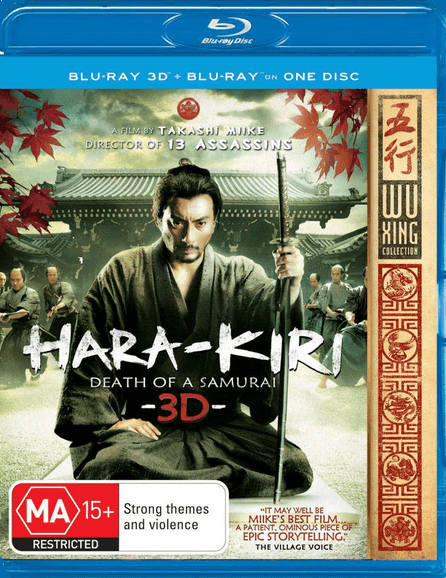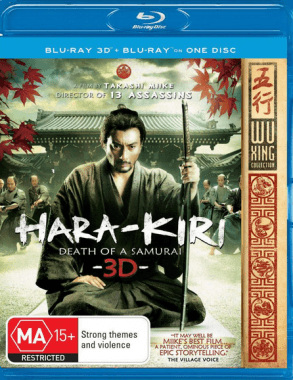
Hara-Kiri: Death of a Samurai
Studio: Shochiku
Publisher: Icon Home Entertainment
Format: DVD, Blu Ray (Reviewed)
Release Date: August 14th, 2013
Price: $29.95 – Available Here
Overview
Samurai tales often glorify the code of honor and laws by which the samurai live. Takashi Miike’s Hara-Kiri: Death of a Samurai is not one of those tales. The bloodshed and honor that defines the samurai is brought into question by Miike in a film that rebels against the ideals that have come to shape the very fabric of Japanese society.
This may very well be Miike at his most restrained. Instead of opting for the bombast he is so well known for he has crafted a quiet moving and emotionally intense drama with Hara-Kiri. Miike has a lot to say with this film and he does so slowly and carefully in what is undoubtedly his most thoughtful film to date.
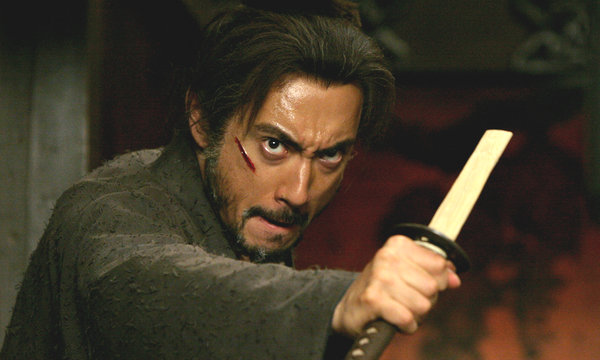
Story
Hara-Kiri: Death of a Samurai as the title suggests revolves around ritual suicide (also known as sepukku/hara-kiri) as as commonly performed by disgraced samurai. In the peaceful times of the 17th century Japan, the samurai business has hit a pretty rough patch. There is no need for warriors without war. The land is at peace and many samurai have fallen to poverty and look to houses for charity or work. This comes to be known as ritual suicide bluffs, with many samurai seeking to gain pity of masters in exchange for a better life. As time goes on the vows to commit seppuku begin to give rise to suspicions and things go bloody from there.
The tale plays out through a series of flashbacks, each unraveling the events that have led the characters to the point in which we see them. Things ultimately turn sour and Miike’s taste for the grisly is on show for all to see. The key here is that Miike doesn’t go all out too quickly, he builds things slowly with a calculated and deliberate pacing that pays off in a big way with the films incredible climax.
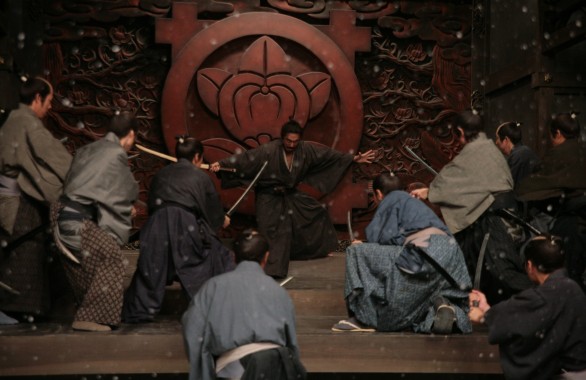
Not having seen the 1962 original, I can not say with certainty whether the themes expressed are lifted from the original or inserted by Miike, but it is clear that the film is very much against the code of honor and respect by which Japanese society is heavily ingrained, it picks a part the concepts and rules and highlights how flawed they truly are. There is no logic behind it, just blind belief in the system and structure, the machine by which the society is founded. The is no justice, no fairness, no honor. Miike brings this to light and seemingly draws parallels to modern Japanese society, condemning it and begging for a change.
It is the film’s insistence on not glorifying the samurai life that makes it so very special. While by Takashi Miike’s standard it is actually a fairly conventional film, it is the messages conveyed within it that set it apart. Samurai lived by a corrupt code and Miike does not hold back in showing the brutality and senselessness of it all. Hara-Kiri is not as exciting as Miike’s other works, but it is immensely fascinating none-the-less.
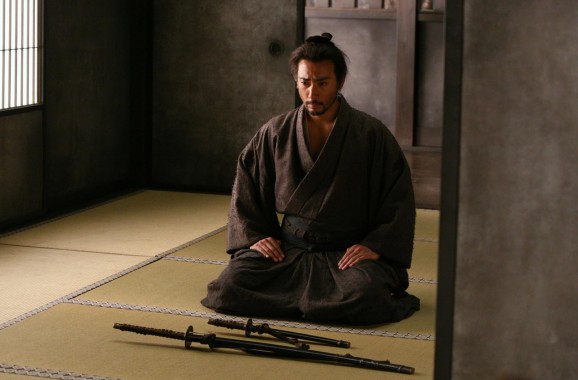
Visuals and Audio
In terms of aesthetics, the film has a cold and chilling atmosphere that is juxtaposed by the harsh redness of bloodshed. Hara-Kiri beautifully captures the era for all its stoicism and tempered aggression. The sprawling landscapes one imagines of Japan are not the main event here, instead Hara-Kiri features a claustrophobic feel, trapped within the Edo-era walls. Much like the laws of the world that bind them, these samurai are trapped and Hara-Kiri conveys that visually.
The film is also made in 3D. Unfortunately for this review we were not able to test the 3D portion of the movie. But with the impressive fight scenes and lovely setting it would undoubtedly be a pleasure to watch in 3D.
As for the soundtrack, Hara-Kiri is a very quiet film with minimum use of incidental music, many scenes simply being dead quiet. It is the slow building tracks that give way to the film’s tension however. The tracks that are used are used sparingly and when they are put into play they only add to the action on screen, never distracting or detracting. It is an intriguingly silent soundtrack, but one that complements the film just fine.
Extras
This particular Blu-Ray release from Icon Home Entertainment does not happen to feature any real bonus content, but it does feature an option to view the film in 3D. If you have a 3D television, this is of course an option you’d like to take advantage of. However, apart from this, there is not much else on offer in this release in the way of extras.
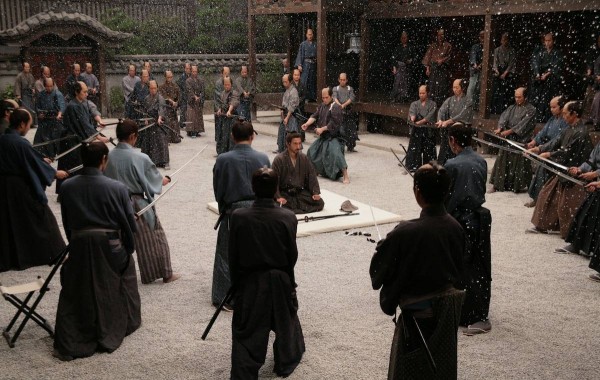
Overall
If you are looking for the irreverent samurai action of Takashi Miike’s 13 Assassins, you won’t find it in Hara-Kiri: Death of a Samurai. This is undoubtedly a very different film for Miike and it is all the more interesting for it. While it is not the most flashy samurai flick or the most exciting one you could pick up, it may just be the most thought-provoking.
Hara-Kiri brings the very concept of the samurai into question, stripping back all the things that make samurai such glorified figures. This is not your average samurai flick, but what Hara-Kiri is is something remarkable. This may be one of the most fascinating samurai films ever made and it is yet another feather in Takashi Miike’s cap.
Much like it’s protagonsit, Hara-Kiri is a film that rebels against the status quo and sets out on a different path to it’s peers. It takes the genre and Miike’s career in an interesting new direction. Hara-Kiri is a special film and perhaps one of Takashi Miike’s best. It may not be a perfect but Hara-Kiri: Death of a Samurai is an intensely captivating film that will have you thinking about it long after its swords have been sheathed.

Capsule Computers review guidelines can be found here.


